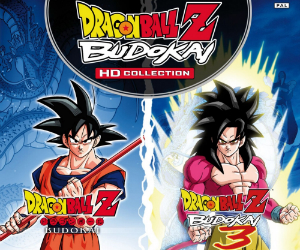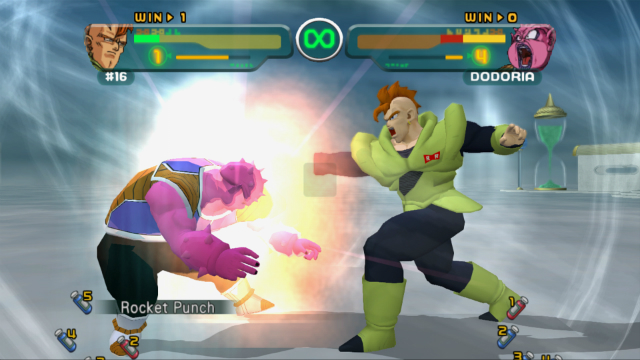 Game: Dragon Ball Z: Budokai HD Collection
Game: Dragon Ball Z: Budokai HD Collection
Developer: Pyramid, Inc/DIMPS Corporation
Publisher: Namco Bandai
Available on: Xbox 360, PlayStation 3
Reviewed on: Xbox 360
Let’s face facts, the Dragon Ball Z: Budokai games have never really been anywhere near to challenging the likes of what Capcom, SNK, Namco or Arc/Sammy have had to offer to fans of fighting games. The Dimps-developed Budokai titles have, however, been very popular with the animé crowd, transporting players into a vibrant and colourful brawl set in Toriyama-san’s universe, as seen in Weekly Shonen Jump or on Toei’s manic television series.
The early PlayStation 2 (and a bit later, Gamecube) Budokai titles were simplistic fighters, with a wide range of characters battling using a combination of standard kicks and punches and the bombastic Ki blasts and special attacks based upon the signature moves from the source material. Although they lacked the technical prowess of a Soul Calibur or Tekken title, the Budokai games were big, dumb fun, and what we have here is a collection of two of the mid-Noughties titles, given a HD makeover, and gathered on one disc. I have been party to several of these high-definition re-releases over the past year or so, as a cursory glance at my GodisaGeek.com profile attests, and some of these, like the insanely good Okami HD, manage to take a relic from the PS2 era and remind you of just how great the original was, whilst making just the right amount of improvements to justify a 2012 purchase. This collection is a bit of a game of two halves, to use the oft-trotted out soccerball cliché. On one hand it shows how sometimes things are better left in the annals of time, whilst at the same time offering a very welcome opportunity to revisit one of the most solid animé tie-ins ever released.

Dragon Ball Z: Budokai, originally released back in 2002, has not aged at all well. Even with the high def treatment, it looks noticeably inferior to the other game on the disc, and is the poor relation in terms of gameplay, too. It was a poor choice choosing to emulate the PlayStation version, rather than the later Gamecube release which smoothed out the visuals with some cel-shading effects. The game also has the same cruddy introduction sequence from the original, which uses the in-game graphics to play out an approximation of the TV show introduction, although kudos for including the legit opening music from the animé, rather than the inferior US version. Gameplay wise, this is a simplistic 2.5D one-on-one fighter, with 23 selectable characters, and all of your standard modes such as Story and Vs. as well as an in-game shop where you can buy items to customise characters using currency earned in the Story mode, with seven different upgradable parameters. The game follows some of the mental plotlines from the animé and manga (although arguably you do have to play as main geezer Goku to get to the meat of the plot), and in this HD update features the option to play with Japanese voiceover talent from the television series.
Looking past the fact that Namco Bandai have bafflingly omitted the second game in the series, the collection is rounded off by the excellent Dragon Ball Z: Budokai 3. In the first half of the last decade, the Dragon Ball games were wildly popular with adolescents and teens, and hold a special place in the hearts of gamers who pummelled them in their formative years. By 2004, I would have just dismissed a game like Budokai as being a lightweight cash-in when compared to the other fighting games I had been weaned on as a young lad. This meant that I missed out on Budokai 3, which is a surprisingly deep, great looking, and very fun game that looks the bees knees in this new HD incarnation. With nearly double the characters from the original game, a stonking 2D intro sequence, and crisp cel shaded graphics, it is worlds apart from the first game in the series, and has a much-improved game engine to go with the aesthetic advances. It also features the same wealth of modes, unlockable characters, in-game shopping opportunities and customisation options.

The combat system is best described as a combination of the throws and chain combo attacks of a Namco fighter and the faster paced, hadoken-throwing duels of Fighting Street lore. Being a Dragon Ball game, the fighting system also throws in some of the bonkers flying, floating, exploding, all-out super moves ridiculousness you would expect. Your characters can transform during a battle, just like the preceding games, however doing so no longer simply drains your Ki levels. In fact, it is the way the Ki system operates that makes the game so different to the original. Although, in-game, it behaves the same way as charge bars or “super” gauge stocks from other fighters, Ki is vital to the series as a whole; it represents the Force Energy used as the basis for the special powers and martial arts shenanigans in the Dragon Ball universe. Budokai 3 gives every character a base Ki level, which will increase or decrease depending on your actions. Go above your base Ki level and your attack power will increase, dip below and and you will receive a bonus increasing your defence. Performing dodge manoeuvres or teleporting will drain your Ki, too. Everything you do needs to be with a close eye on your Ki levels as well as your vitality gauge. Do you play it safe and conserve your energy for the right moment? Or are you trigger happy and just want to hit the L2 button to enter Hyper mode and finish off your foe with a dazzling ultimate Attack?
There are other new mechanics that made the third canonical Budokai game such fun. Beam Struggles occur when two attacks collide, which sets off a QTE-style rotate-the-sticks face-off, a kind of crazy animé tug of war scenario that can sometimes even result in an Energy Wave Blast Double KO (wooo!). Dodging attacks is an all-new inclusion, and although it costs precious Ki, it certainly makes life easier; particularly as the game can become bloody difficult at times.
VERDICT: The package as a whole suffers from a lack of online play, which is a shame, particularly as most of the core fanbase would have played these games back in the day in bedrooms with their mates, and there is no way of sharing more of those Toriyama-based fun times over an internet connection. The soundtrack is also different from the original games.

Sure, this is mainly because the bloke who composed the original tunes had been accused of plagiarism, but fans will wonder why the games now feature music mainly pinched from the Budokai Tenkaichi titles.
The first game in the series is poor. It looks dated, it doesn’t play well, and is jerky and crude in its execution. There really wasn’t any excuse for the second game in the series (and its Z 2 V update) to be left out, harming the overall value for money. Budokai 3, however, is a terrific game. It shocked me, if I am honest, and it is a game that I have had a lot of fun experiencing for the first time, my snobbish attitude to fighters, be damned! It is almost worth the price of admission alone, however, as I have said many times before, it may be worth hunting down the original title if you have the ability to play PS2 discs, as it will save you a few quid.






